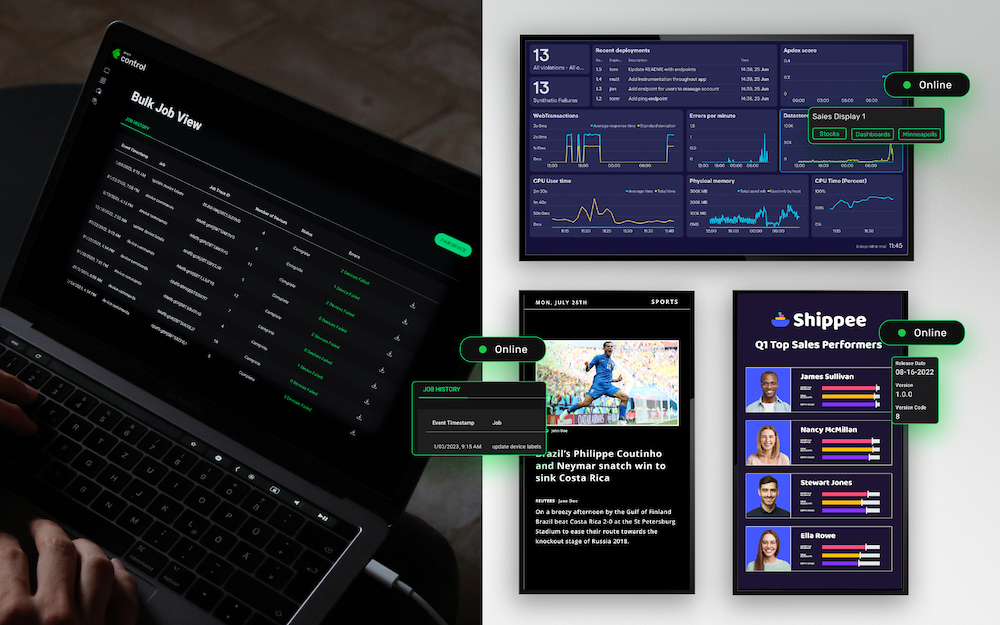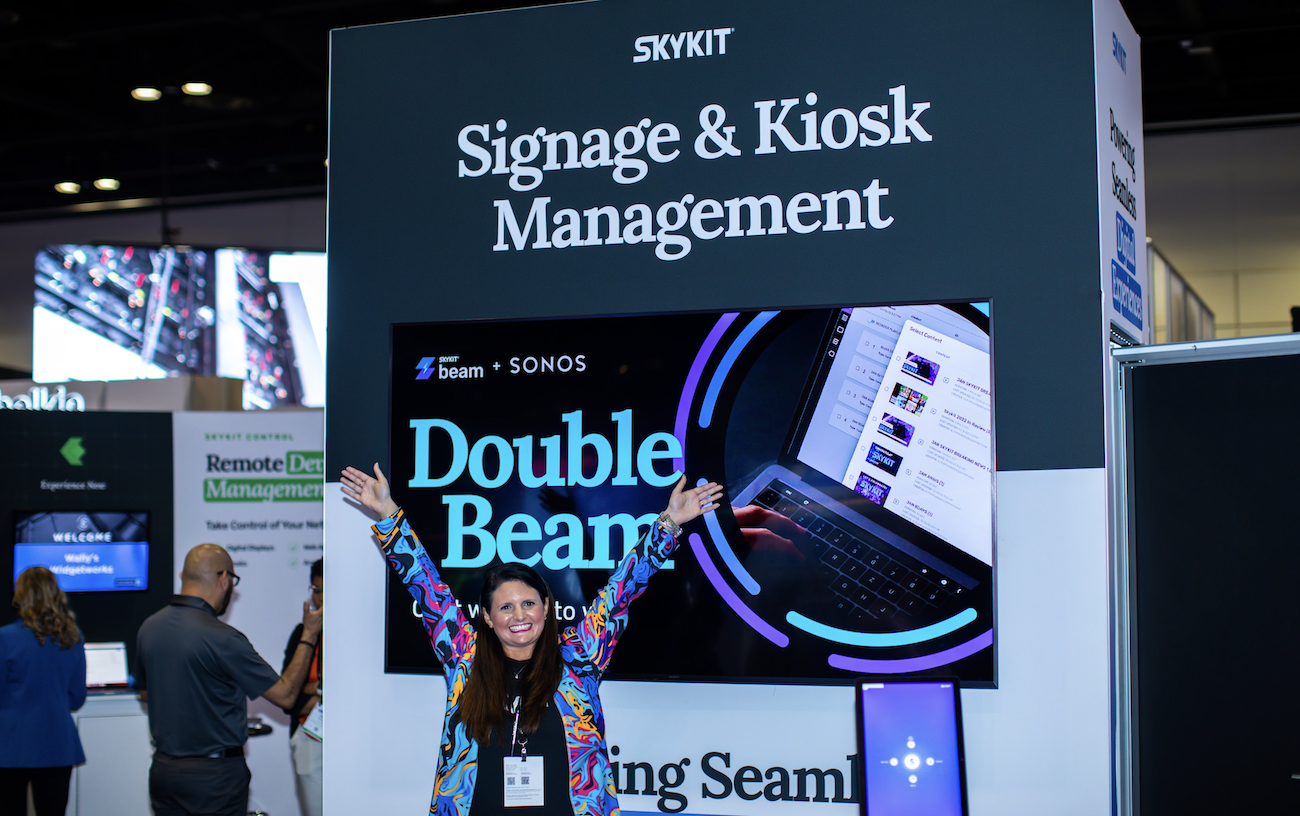If you dabble in digital signage, you probably recognize this figure and what it stands for: $23.76 billion.
No? Doesn’t ring any bells? Shake any trees? Light up any digital signs?
That figure is what market researchers say will be spent in the digital signage industry in 2020. $23.76 billion dollars. That means digital signage is generating more and more interest in various industries across the globe, and those industries are buying in big, big ways.
What industries are stepping up?
Small Business Sector
There are dozens more, but no matter where digital signage is being used, or how it’s being used, the trends users follow shift from year to year. This is because different indicators and developments point these industries toward the direction of digital success.
Is your business headed in the same successful direction?
Let’s find out.
Here are the Top Digital Signage Trends for 2020:
1) Kiosks and Tablets
More and more fast casuals and QSRs are adopting these self-service options for customers, citing convenience and faster service.
And customers appreciate them, too. According to the 2019 Tillster Self-Service Kiosk, more than 65 percent of customers would be more likely to visit a restaurant if self-service kiosks were offered.
Self-service ordering platforms free up employees from the cash register to focus on other aspects of their job that improve the customer experience. And from the customer perspective, self-service reduces the likelihood of order inaccuracy.
As more customers say yes to tablets and kiosks, the more we see restaurants adopting them.
So what does this mean?
It means the trend is growing at warp speed. By 2020, the implementation of kiosks and tablets will only continue to increase.
The self-service digital machines, per various news articles, are already a threat to employees in the fast casual sector. The fact that there is speculation regarding kiosks and tablets replacing workers is a strong indication of an upward growing trend.
2) Interactive Media
As we drive further into the Digital Age, interactive options are growing. These options include mobile interaction as well as human interaction. The more businesses can successfully engage customers with digital promotions, the more good things are bound to happen.
Brand awareness increases.
Sales increase.
And the customer experience becomes memorable.
The customer experience is a critical component of customer satisfaction. This experience is more than the product – it’s the experience of the whole brand.
Take public transportation – a famously frustrating experience for many commuters. In downtown Pittsburgh at the Wood Street Station, there’s an interactive, 8-foot tall kiosk where riders can access schedules and map out an itinerary.
The kiosk even has a trip planning module that lets customers interact with a mapping database and search for specific places to visit. Users can plan their itineraries right on the touchscreens and email it to themselves.
Interactive touchscreens not only provide an improved customer experience, they can also track interactions and deliver vital data that could increase an organization’s bottom line significantly.
With tracking, businesses can identify buying behaviors and trends, as well as hone in on consumer interests.
This is done by anonymously profiling customers. We’ll dig into this intelligent integration in a bit, but for now, recognize that digital marketing coupled with interactive media offers a return on the digital investment.
Why interactive media?
Because it works. It gets people involved.
When Despicable Me 2 was released, marketers created a digital campaign that not only involved human interaction, but included mobile interaction as well.
The campaign invited viewers to control the on-screen action, personalize a message, and then share the message with their friends on social media using their smartphones.
According to Zion Market Research, the global multi-touch screen market will reach USD 22.33 billion by 2025.
The figure is driven by an era of mobile computing and the development of smart computing devices being used in a myriad of ways. Virtually no one today is without some type of wireless mobile device.
3) Customer Profiling
It sounds almost criminal, doesn’t it? But of course, it isn’t.
Customer profiling allows stores or businesses to anonymously gather information and purchasing trends that customers provide every time they buy.
Digital signage software offers this option and various industries are taking full advantage of it.
With digital signage giving the ability to gather and store data that tracks customer trends and other pertinent information in a handy database, there is no question that industries everywhere will soon incorporate this integration into their digital systems, if they haven’t already.
For example…
Analytics and marketing provider Walkbase, in a joint venture with Samsung, is providing in-store analytics to retailers looking to serve their customers to the highest degree.
The digital platform anonymously analyzes customer behavior through Wi-Fi signals from customer smartphones, and provides specific insights to the user.
What kind of insights?
Well, which path a customer takes when they walk through the store, what kind of merchandise they look at, and exactly what their buying behaviors are.
The data is then used to offer in-store digital advertising to customers.
More specials show up and more merchandise flies off the shelves.
Does it really work that way?
Yes. It actually does.
On-going analytics are fed into content management systems (CMS), which allow the campaign to continually update to ensure maximum impact in the sales realm.
Retail giant Walmart uses profiling to increase sales and deliver exceptional customer service.
As of May 2019, sales at Walmart stores in the U.S. open for at least 12 months were up 3.4 percent, the best growth of that metric during the first quarter in almost a decade.
To achieve this figure, Walmart collects and analyzes customer data – every day.
They collect 2.5 petabytes of data from 1 million customers each hour. One petabyte is equivalent to 20 million filing cabinets.
Crazy, right?
Customer profiling and data integration are creating better customer experiences. When the experience is better, customers come back.
That’s just the nature of good customer service, digitally speaking.
4) More Social Media
Social media is a major marketing channel for business. And with 40 percent of the planet’s population on social media, it’s more important than ever to integrate with the strategy of your digital signage campaign. Consider these statistics:
- 366 million new people started using social media in the past year. That’s more than a million new people joining social media every single day. (Hootsuite)
- 54% of social browsers use social media to research products. (GlobalWebIndex)
- If your Facebook ads contain images, then they will be between 75% and 90% more effective. (Consumer Acquisition)
- People are 31% more likely to recall what they saw on Twitter vs. general online browsing. (Twitter)
- 53% of users say they bought a product they first saw on Twitter. (WebFX)
- 71% of US businesses use Instagram. It surpassed Twitter in business users in 2017. (eMarketer)
- YouTube is the preferred form of social media marketing worldwide. 83% of all consumers prefer it. (Hubspot)
That’s a lot of buying power on social media.
5) Indoor LED Screens
With the growth of LED and the ever-growing technological advancements displays now provide, LED solutions have become more attractive and more affordable for users.
Because LED screens have many advantages, like being energy efficient and long lasting, organizations and businesses are migrating to the purchase of LED. The colors are vibrant and rich, providing greater visuals for users.
This high-quality commercial screen has been generally used outdoors, but the trend is also shifting indoors.
While some may struggle with whether or not they should go with LED versus LCD, LED technology offers options that are pulling more and more digital users to its bright and rich disposition.
Conclusion
The global digital signage market size is expected to reach $29.8 billion by 2024, according to Reportlinker.
With trends pointing in the direction of more affordable technology, useful data integration options, and kiosks allowing personal ordering, it’s easy to see how the industry will further grow, and in which sectors it will blossom.
The retail and restaurant industries are certainly proof of digital sign explosions. The examples are endless.
The possibilities are extreme.
And the technology is edgy.
Be prepared for the billion-dollar explosion. It’s sure to blow your digital mind.
What industry do you see digital signage growing in? Do you see a trend that we don’t? What is it?
Last updated: 11/14/19



